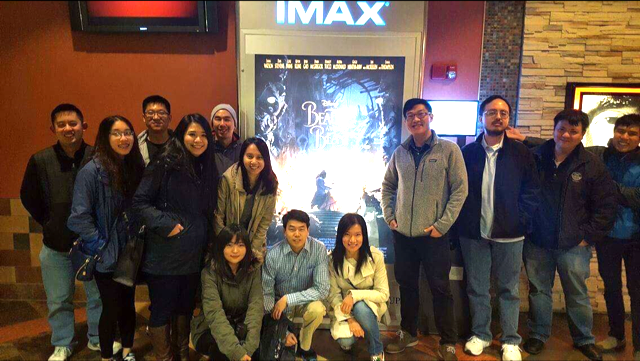By Staff
NORTHWEST ASIAN WEEKLY

Hang-Ping and John’s Movie Group watched Beauty and the Beast in IMAX 3D at Northgate’s Regal Thornton Place Stadium 14. (Photo by Charles Liu)
Asian Americans were the biggest moviegoers in 2016 compared to any other ethnic group in the country in terms of per capita ticket buying, according to a new report by the Motion Picture Association of America (MPAA).
The MPAA defines frequent moviegoers as people who go to the theater at least once a month.
It found Asian Americans went to the movies 6.1 times on average, followed by Latinos who went 4.6 times.
Meanwhile, Black moviegoers accounted for an average of 4.6 times. As for whites, they frequented movie theaters 3.2 times.
“It’s a promising trend, and I hope that it continues,” said April Reign, a writer and editor from D.C. who started the hashtag campaign #OscarsSoWhite in 2015 when the academy did not nominate a single actor of color for its top honors for 2014.
This year’s Oscars were notably more diverse — not only did the coming-of-age drama “Moonlight” win, but its star Mahershala Ali nabbed best supporting actor and Viola Davis picked up a supporting actress statue for her work in “Fences.” Indian actor Dev Patel was nominated, but did not win.
“I definitely think it has something to do with the fact that there are more characters of color and those from marginalized communities on the big screen, the small screen, and on the stage.” Reign continued, “People are interested in seeing stories that center on people that look like them, or just stories that are different from what we’ve normally seen.”

Variety noted that while Asian characters were portrayed in blockbusters, such as “Rogue One: A Star Wars Story” and “The Magnificent Seven,” the film industry has a habit of “whitewashing,” which has sparked outrage. “Ghost in the Shell” and “Doctor Strange,” for instance, both cast white actors to play characters that had originally been Asian.
In an unrelated study by the University of Southern California, it was revealed that out of the top-grossing films in 2015, white actors played 73.7 percent of speaking or named characters. The researchers discovered that only 12.2 percent of speaking or named characters were Black, 5.3 percent were Latino, and 3.9 percent were Asian.
MPAA Chairman and CEO Chris Dodd said in a conference call following the release of the report, “The numbers (for Asian and Black audiences) went up, again — this year, it could’ve been due to ‘Hidden Figures,’ ‘Fences,’ and ‘Moonlight.’ I don’t know if that would explain the Asian numbers, but having products out there that audiences can relate to… there is certainly an effort among studios to achieve more inclusion and participation in minorities and gender. We are trying to do a better job and it deserves being done.”
Although the international box office stayed stagnant, the report claimed that the box office in the Asia Pacific region increased 5 percent from 2015 to 2016, earning $14.9 million last year. Japan and India were the primary drivers of growth, with a 27 percent increase and a 28 percent increase, respectively.
However, after more than a decade of consecutive gains, China’s box office actually decreased by 1 percent in U.S. dollars from 2015, although it increased slightly (by 4 percent) in local currency.
The report also found that women comprised 51 to 52 percent of total moviegoers consistently since 2012, and that percentage did not change in 2016.
Staff can be reached at info@nwasianweekly.com.



